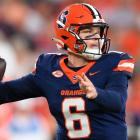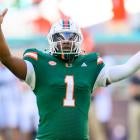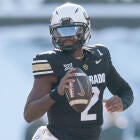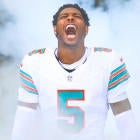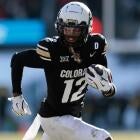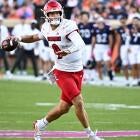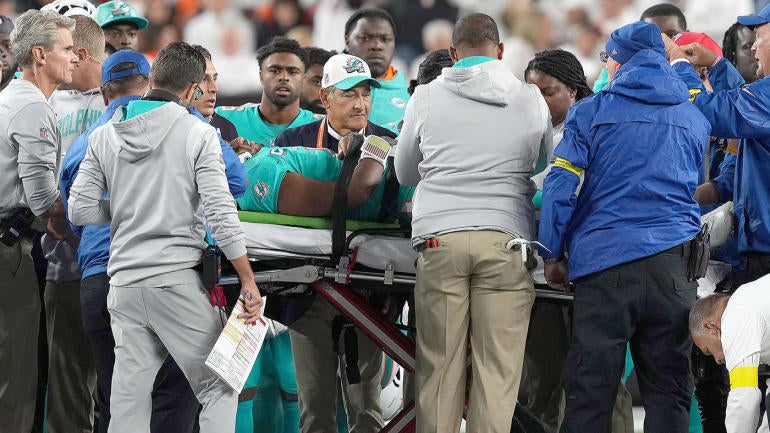
The major headline from Week 4 of the 2022 NFL regular season may have been made on Thursday night after Miami Dolphins star quarterback Tua Tagovailoa suffered injuries to his head and neck that caused him to be stretchered off the field and transported to the University of Cincinnati Medical Center via ambulance. While Tagovailoa was eventually discharged from the hospital and able to fly home with the team, questions remain if he should have even been playing on Thursday night.
Tagovailoa suffered a big hit last Sunday against the Buffalo Bills, when he was knocked backward and hit his head on the field. The Alabama product got up and appeared to be woozy, even dropping down to the ground again before teammates held him up safely. He exited the game and apparently passed concussion protocol, with the Dolphins classifying his injury as a back issue. The NFLPA said afterward it was going to investigate the situation.
Tagovailoa was questionable to play Thursday against the Bengals due to back and ankle injuries. He suited up, but during the second quarter he took a hard sack and his head violently hit the field -- leading the quarterback to go into a "fencing response", where he raised his hands eerily as a neurological response to head trauma.
Should Tagovailoa have been allowed to play Thursday night? Why did the Dolphins classify his initial injury as a back issue? What is a "fencing response," and why was Tagovailoa discharged from the hospital so quickly and allowed to fly? On Friday, CBS Sports spoke with Dr. Rahul Shah, who is a board-certified orthopedic spine and neck surgeon. He also gave us some insight into what happened during the scary scene on Thursday night.
CBS Sports: The hit that Tua took last Sunday, every NFL fan thought he suffered a concussion when they saw it, and of course he got up wobbly. But the Dolphins classified it as a back injury. Is that possible with the hit you saw?
Dr. Shah: Yes, absolutely.
If you hit the head or if the head gets affected, you're going to potentially affect -- when that head bobbles backwards and forwards -- you're potentially going to irritate the structures not only where the head is, but also where the neck and where the head hinges over the torso, and the same thing can happen with the torso hinging over the back.
So with the hit that Tua took Sunday, is it possible that he could have suffered a back injury or something more to the spinal column without injuring specifically the head?
Correct. There are a couple of things that are in play at the time of the injury itself. When you get hurt, your body naturally releases a bunch of adrenaline. And you know about that, where people are not able to necessarily feel some parts of their body where they potentially hurt parts of their body and don't even know, because the adrenaline is taking over.
The rest of his body had to also crumble or take a hit when he fell. Those areas may have been injured at that time and we didn't even pay as much attention to it, because we were just paying attention to that one area. So you're distracted by one area, and not paying attention to the rest. So any part of his spinal column potentially could have been injured -- not only at the time of the hit but potentially when he reacted to the hit. Now, on top of all this, if he has an area which is already fragile, well we know that area is going to get even hurt more when you have a hit.
Last night, we saw something that was very clear in the "fencing response." Can you tell us a bit more about that and why exactly that happened?
So what happens is when the head gets a hit, it basically snaps backwards. So when you have this type of scenario, this whole structure basically gets affected and what will happen is the person gets knocked out and they basically have this decorticate response. Basically, think of it as a short-circuiting that's occurring that's going all the way to the fingertips. And that's what it's showing -- it gives you insight that the base of the neck or that brain area is still fairly fragile, particularly after the fact that he's had his prior injury.
So you think that his prior injury played a part into the fencing response that we saw last night?
Yeah because think about it, the areas have to heal over time. If you have a small scrape or a small cut on your fingertip, you'll heal in a couple hours or maybe in a couple of days. If you have a significant injury to say a bad bruise or something, that can take a couple of weeks to get better. And if you have a broken bone, that takes a couple of months to get better, but nerves follow a different trajectory. They kind of fit in to that area where it takes a couple of weeks to a couple of months for a lot of that to settle down. But because these are such high-level athletes, it's so difficult to know exactly the full extent of the initial impact and that area is still a little bit more fragile, so you get hurt again, the areas that are fragile are going to get worse.
If he did not hurt his head on Sunday and he took that hard hit on Thursday night, could he still have that fencing response?
That is possible, but you have to use evidence here. You get hit back-to-back, you can't say the first one has nothing to do with it. It's like, I see a smoking gun and I see a bullet. Maybe the bullet and the smoking gun aren't related, but if the bullet is hot and the smoking gun is hot ... you see where I'm going.
With how you observed the injury Thursday night, was that a concussion, was that a neck injury or was that a mix of both?
The fact that the arms went up et cetera, you've got to look at the concussion and the brain first before you start looking at the neck. Because if it's just a neck injury, it typically just affects one side, both arms went up. And if both arms went up and you can't use the legs, then that's more of a neck issue. So I think this is really closer to the brain stem or closer to that brain area, and I think that that's where you want to start your investigations, and then you work down.
What happens to someone if they suffer two concussions in five days?
It's so hard to tell. Depends on the severity of each one, but yeah, prognosis starts to drop off.
What does that mean?
It's a combination of two things: One, the severity of each injury. So, you have the one injury and then you have the second injury. Are they additive? And is he much worse after that second injury as compared to the first injury? You have to look at that. So his response to the injury that he had. That's the first thing you've got to do. You would expect that he would bounce back slower from the second injury than the first injury because the injuries are cumulative.
I would say that the prognosis gets a bit more poor after that second hit particularly so close together and the fact that he had that decorticate or that fencing response that we talked about.
Even if that initial hit he suffered Sunday wasn't deemed a concussion, there's obviously risk for someone going forward after experiencing what could be a legitimate headshot. Can you talk about how dangerous it could be just that Tua played last night?
We are always taking hidden risks. You've got to look at it in two separate scenarios: On the one hand, let's say he got hit last night and had no hit before (Sunday). If the force on that hit was enough, he could certainly damage himself significantly enough to give him that decorticate response (fencing response). Now, if he has an injury before that, you have to be suspect or you have to be suspicious that that first injury predisposes having even a smaller hit causing a problem.
The other way to look at this question is if I had the injury a little while ago that we didn't deem as a concussion, and now I'm a little bit more fragile and I get hit again, what are the chances that I get it significantly worse, and, of course, the chances are higher. So now if he gets hit a third time in a short amount of time, this is going to bode to be even worse.
There has been a ton of uproar because Tua played last night in the first place. Was that a mistake? How could something go wrong with the process behind the scenes?
There's no test of battle, like battle. I can examine professional football players, basketball players -- and I do all the time. But my exam and what I do and what I go through ain't the same thing as getting hit on game day. There's just no way to do that. So what we look for are footprints of injuries that we know people can't survive from. If he had those, he wouldn't have been able to play in the first place. So now you're dealing with somebody who is a very high-level athlete, who has the will to play and has findings that don't necessarily always come out.
So is he injured enough that he can play through it, or that he can't? Unfortunately, the only way to do that is to go through the game itself. Do I think that there was a mistake in terms of letting him go back to play soon? I can't say that with any real clarity or conviction because from what I see, he was able to start, he was able to do what he needed to do. Was he at his 100 percent peak? Hard to always tell because every game is different. We got the feedback from the hit (Thursday night) that told us pretty clearly and pretty accurately that he was a bit more susceptible with that particular hit. Now, is that particular hit on its own enough to cause (a fencing response)? Maybe, right? But we do know that because he's had a series of these, it now fits a pattern, and we need to be more careful and more protective to try and limit additional injuries or damage.
Is it OK for someone to fly home just a couple of hours after suffering what appeared to be a severe head injury/concussion?
So I don't know the tests they ran over there. The real issues you want to make sure is that someone doesn't have an active bleed or someone doesn't have an active swelling in the brain or things of that nature -- that is threatening function. Those are the things that they are basically looking at while he's there. Right after the injury, they are also checking his examination and they are making sure that things aren't evolving. So as long as he's fairly stable in a short amount of time -- the flight wasn't a 36-hour flight. He's getting on a plane for a short flight. That's reasonable, that's no different than potentially taking a five- or six-hour transit to go somewhere else as long as you're monitored, and they already had enough information to give them the confidence to go there. And as you can see, he gets off the flight and he's able to still continue where things are, and he doesn't dramatically get worse because they check for that.
With the injury that you observed Thursday night, what do you think the recovery timeline could be for Tua?
It's too early to tell. The [fencing reaction] is what's concerning. I would probably want to see how he handled practice first, make sure that he felt OK to get to practice, start practice and see how he did. Because you want to take a step-wise progression towards entering full sport. You want to see how he does, give his brain some rest, give his cognitive system a rest and then start to slowly increase. And it all depends on where he is on the spectrum.
Do you have any insight to offer as to the NFL's concussion protocols or what the league could do differently moving forward?
I gotta tell you, they have made such incredible strides. Concussion wasn't even on the radar screen 10 years ago -- I mean it was, but nobody really talked about it. They are so vigilant right now. They understand traumatic concussions, they understand how traumatic concussions are cumulative over time and they understand the importance of different tackling regimens and responses to getting hit and things of that nature, so they have come a very long way. At the end of the day, the dirty secret, the actual truth is some of these things are so difficult to quantify because they are incremental.
What the NFL has done with their guidelines, with their concussion protocols, with their traumatic injury protocols, with their traumatic brain injury protocols has been night-and-day difference, and I want to really applaud them for the type of work that they've done, because they have really come a long way.
![[object Object] Logo](https://sportshub.cbsistatic.com/i/2020/04/22/e9ceb731-8b3f-4c60-98fe-090ab66a2997/screen-shot-2020-04-22-at-11-04-56-am.png)










